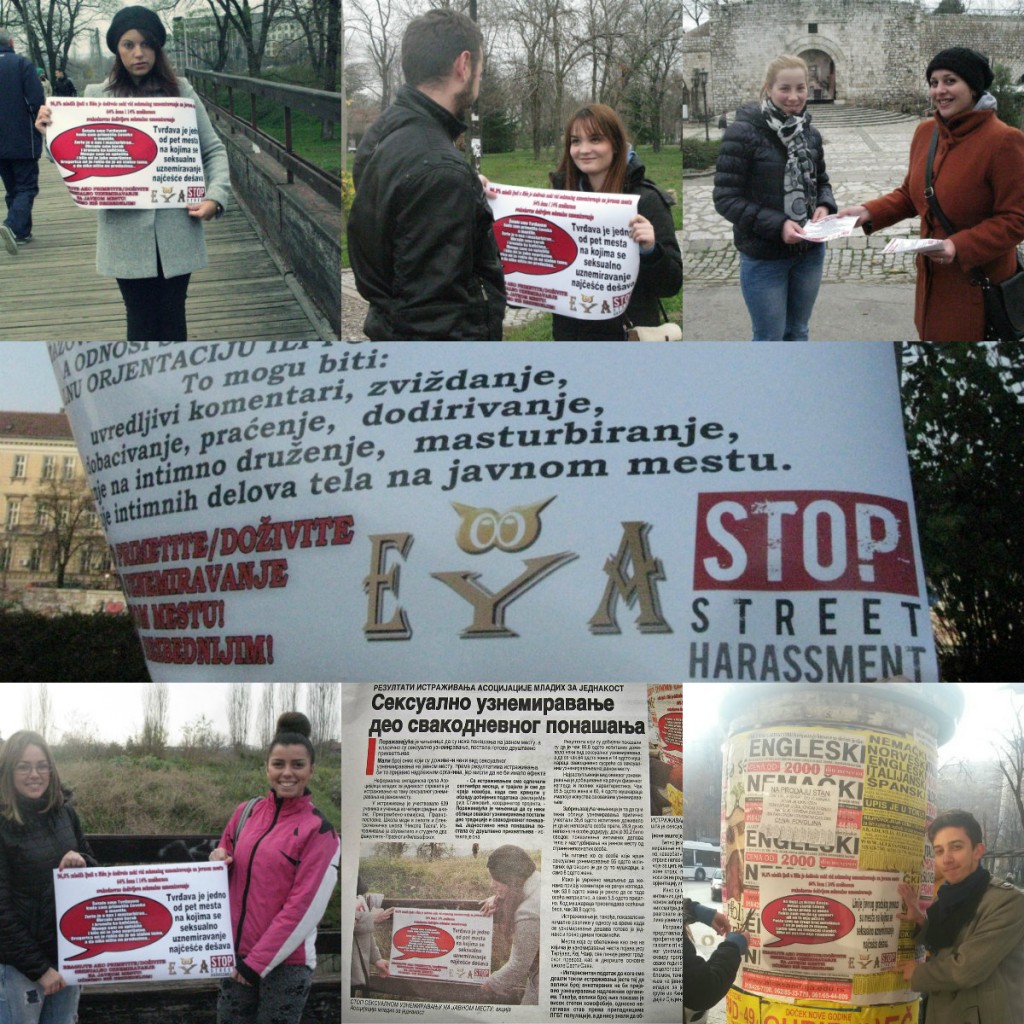This post is from our Safe Public Spaces Team in Nis, Serbia. The SPSM projects are supported by SSH donors. If you would like to donate to support the 2015 mentees, we would greatly appreciate it!
“How is that street harassment when everyone does it?”
Equity Youth Association conducted a street harassment survey across three months with 629 youth participants from four secondary schools and two Faculties. Psychologist Sanja Cvejić helped us process the data. The findings are below the collage image. We also handed out a flyer with a basic explanation of what street harassment is and the most common forms and through that we were able to educate and raise awareness among even more people.
School psychologist were delighted that this issue is finally being addressed. They were so concerned with our statistics that they encouraged us to start a session of educational workshops on street harassment in the future.
After reading our report in local newspapers, members of the Board Commission for Gender Equality of the City of Nis decided to conduct another survey that will be focused on finding out where women of all ages feel unsafe the most and then developing a strategy for further securing of these parts of the city.
SURVEY FINDINGS:
The statistics were so shocking that we double-checked everything:
* 96.8% of participants experienced some form of sexual harassment at least once in their life.
* 64% of women and 14% of men said they experience harassment on a daily basis.
* The most common form of harassment cited were comments about people’s physical appearance: 84.2% of respondents have experienced this type of behavior, 95.5% of women and 60.4% of men.
* It doesn’t come as surprise that the most common form of harassment is not recognized as harassment at all. Only 18.5 % of respondents said yes that unwanted comments about physical appearance is sexual harassment. 48.9% said no, and furthermore, most of them added that this is compliment.
* What is also worrisome is the fact that 35.5% of girls and 16.6% of boys said they witnessed public masturbation and 33.8 % of girls and 23.1% of boys experienced inappropriate touching by unknown persons.
* We started from a neutral position where we assumed that gender makes no difference when it comes to street harassment. Of course, we were proven wrong. For every type of behavior, women face it more frequently than men.
* 55% of participants said that their harassers were men and only 8% that harassers were women.
* The most common feeling that participants had when they experienced harassment differed a lot between men and women: 53.6% of women feels uncomfortable, while 38.8 % felt angry.
* When it comes to positive feelings, 7.3% of men felt desirable as did only 3.4% of women. 6.2% of men felt flattered as did only 2.6% of women. 4.1% of men said it made them feel phenomenal while no woman selected this.
* Some people admitted to being harassers: 8.8 % of boys and 4.8 % of girls. Of them, 41.3 % of boys said they had made comments about physical appearance as did 18.2 % of girls. 24.5% of the admitted male harassers and only 8.2% of admitted girls harassers said they inappropriately touched (rubbed against) a person they don’t know in public.
* The most common reaction that participant had when they experienced harassment was to just get away from the harasser (37.7%). Only 3.1% of people screamed or asked for help. It’s worrying that 65.6% of people believe that police wouldn’t react if they would address them. But, what worries even more is that people become so oblivious and used to street harassment that nobody is reacting not even to public masturbation.
A female participants shared with us: “In the middle of the day in the pedestrian zone, in the city center man was masturbating. No one reacted. Everybody in our country should be ashamed of this.”
* 40.5% of respondent has experienced harassment in public transportation where reaction is lacking as well: “I felt that the older man is rubbing against me. I told him to back off and moved to the back of the bus. He came after me. None of the people in the bus reacted. I came down on the next station.”
* More than half of the harassed people (57.9%) said they first experienced harassment at age 13-17. The story of the girl who was only seven when she first experienced harassment left me speechless. “I was coming home from school when I noticed a car driving very slowly next to me. Inside was a man masturbating and staring at me.”
* What also took me by surprise is the reaction of a fellow law student: “Oh come on, catcalling is street harassment? But, everybody does it.” And indeed they do. According to our survey, harassment is happening everywhere. Elementary school yards, public parks with kids, coffee shops, clubs.
* And, it’s widely believed that women are the one to “blame”: 56.2% of participants believe that women who wear short skirts deserve catcalling on the street.
If there is any silver lining to these dreadful statistics that would be that many people are willing to change. We were pleasantly surprised by the media reaction. Our survey results were published in local newspapers, featured on website and announced on the radio. During our street action many people showed interest in topic and have supported our work. But, what gave us hope the most are school psychologists that have suggested us collaboration.
Hopefully, soon we were be able to come up with form of education on the topic of street harassment that could change the way young people think and act.
Marija Stanković, Equity Youth Association and the lead SSH Safe Public Spaces Mentee in Serbia.

